Search results for 'mediums for oils'
-
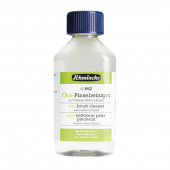
-
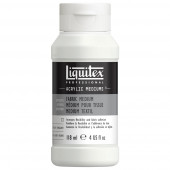
Liquitex Acrylic Fabric Medium
Starting at: £12.35
Enhances blending, workability, and adhesion of acrylic colours for painting acrylics directly on to fabric. Reduces paint stiffness. No heat setting required. Learn More -
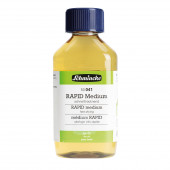
-
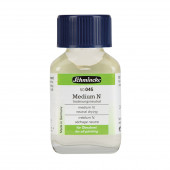
Schmincke Medium N
Starting at: £9.45
This product does not contain turpentine, and is therefore suitable for artists with allergies. A 'neutral', nearly non-yellowing painting and thinning medium for oil colours. Applicable for all painting techniques except for ground motifs on slightly absorbent undergrounds (not “lean” enough). Low impact on drying time. Thinner: Terpin (50023) (max. 30%). Dosage: 10 to max. 20%. Learn More -
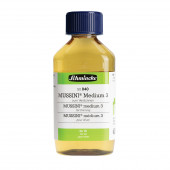
-
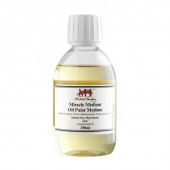
Michael Harding Oil Paint Miracle Medium
Starting at: £12.60
Introducing Michael Harding Solvent-Free Mediums: Miracle Medium™—crafted for artists seeking safer, eco-friendly alternatives to traditional solvents. Derived from renewable vegetable sources, our Miracle Medium offers an odourless formula, eliminating the need for solvents in your studio. With MH Miracle Medium, artists can enjoy a studio environment free from harmful effects associated with solvents. The Miracle Medium™ plant-based range not only ensures environmental sustainability but also creates a safer space for artists and their loved ones Learn More -
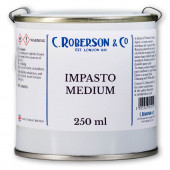
Roberson Impasto Medium
Starting at: £16.50
Roberson Impasto medium is a crack-resistant medium for impasto effects. It retains palette knife and brush strokes, giving the paint sharp, defined edges. It remains thick and doubles paint easily, drying to a matte finish. To retain colour strength, mix one part medium to one part oil colour.
Contains: Stand Oil, Damar Resin, Turpentine, Bleached Beeswax.
Learn More -
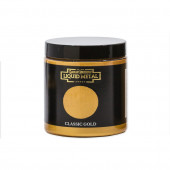
Roberson Liquid Metal 250ml
Starting at: £18.90
Roberson Liquid Metals have a rich deep colour, ideal for a wide range of applications including plaster, wood, paper & canvas. The Liquid Metal range does not tarnish and does not need to be varnished. All colours are intermixable and wash up with water. The Liquid Metal range does not tarnish and does not need to be varnished. All colours are intermixable and wash up with water. Coverage is approximately 7 square metres per litre. Two coats are required for most applications but if applied to walls or ceilings with a roller or a brush then three or four coats are recommended. Because of the highly reflective nature of the metallic paint when applying with a roller to a large area apply the paint evenly in long vertical strokes, finishing off the surface by rolling or brushing in one direction, i.e ceiling to floor. This will help to minimise overlapping and create a smooth and even finish. We recommend the use of a professional quality foam roller in order to achieve the best possible finish. When applying with a roller to a large area, apply the paint evenly in long vertical strokes. Finish off the surface by rolling one direction, i.e. ceiling to floor. This will help minimise overlapping and create a smooth, even finish. These paints can also be sprayed and this will produce the best and most consistent finish. To spray Liquid Metal Acrylics, you will need to use HVLP spray equipment with a 1.6mm or 1.8mm nozzle. To ensure proper flow, paint can be thinned with 25-30% water. Learn More -
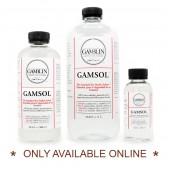
Gamblin Gamsol Mineral Sprit
Starting at: £9.30
Gamsol is an odourless mineral spirit created by the American company Gamblin. They describe it as "the safest solvent that allows oil painters to utilize all traditional painting techniques without compromise."
Please see below for Gamsol's primary applications.
Learn More -
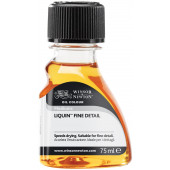
Winsor & Newton Liquin Fine Detail
Starting at: £9.20
From the Winsor & Newton website: The most fluid of the Liquin family of products, this quick drying, gloss medium is ideal for fine details, glazing and blending, or to produce a smooth surface picture. Speeds drying (touch dry in 1-6 days depending on colour and film thickness).Resists yellowing. Not suitable as a varnish or final coat.
Learn More -
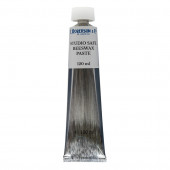
Roberson Studio Safe Beeswax Medium
Starting at: £18.60
A safe wax medium for impasto effects. This medium retains palette knife marks and brush strokes, remains thick and doubles paint easily, drying to a matt finish.
Studio Safe products are non-aromatic, non-flammable, and have a pleasant orange smell.
Learn More -
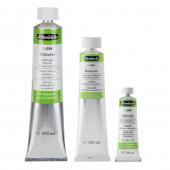
Schmincke Malbutter Impasto Medium
Starting at: £8.20
A gel medium that increases the buttery character of oil colours and decreases their drying time. Useful for impasto techniques and knife application. Add to oils in a maximum ratio of 1:4. Contains alkyd resin.
Learn More -
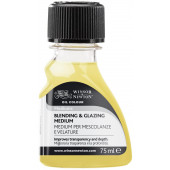
Winsor & Newton Blending & Glazing Medium 75 ml
£9.20From the Winsor & Newton website: This new medium slows drying & improves flow. Ideal for blending, glazing, stroke work, antiquing and staining. Improves transparency and depth. Dries to a durable gloss finish.
Learn More -
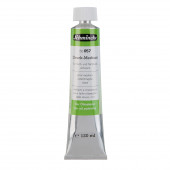
Schmincke Print Medium Black 120 ml
£15.95For relief and intaglio printmaking with black oil paints. Learn More -
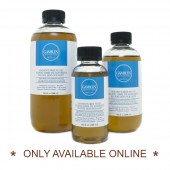
Gamblin Solvent-Free Fluid Medium
Starting at: £12.60
Gamblin Solvent-Free Fluid is an oil painting medium created by the American company Gamblin. They write:
"Gamblin Solvent-Free Fluid painting medium gives oil colours more flow and transparency. It has a moderately fast drying rate and increases gloss. Made from safflower oil and alkyd resin, Gamblin Solvent-Free Fluid is non-toxic and contains no Gamsol or petroleum distillates. To ensure proper drying and prevent beading-up of paint layers, Solvent-Free Fluid should be used in moderation with oil colours – no more than 25% by volume. To avoid wrinkling, apply mixtures of Solvent-Free Fluid and oil colors thinly. For underpainting, we recommend adding Gamsol to Solvent-Free Fluid."
Learn More -
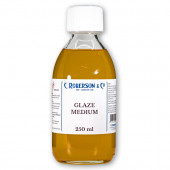
Roberson Glaze Medium
Starting at: £9.60
Mix with tube oil colours or pigment to improve flow and translucency. For thin glazes, fine details and smooth brushwork.
Contains: Turpentine, Damar Resin, Stand Oil, Cobalt Dryers.
Learn More -
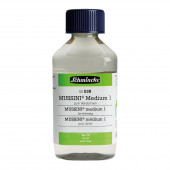
Schmincke Mussini Medium 1
Starting at: £9.45
Low-fat (lean) painting and thinning medium for oil colours. Recommended for thin grounds and for creating transparent layers over gouache, tempera and acrylic paintings. Thins with minimal affect on drying time and gloss. Dosage: 10% to max. 20% Contains: Safflower oil, natural and synthetic resins, mineral spirit. Learn More -
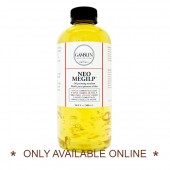
Gamblin Neo-Megilp Medium
Starting at: £12.00
Neo-Megilp Medium is produced by Gamblin. They say:
"Neo Megilp is a contemporary version of Maroger. This soft gel medium maintains the body of oil colours, increases transparency and flow, and imparts a smooth, silky feel. Neo Megilp dries at a moderate rate and remains workable for hours. Neo Megilp gives colours a satin gloss."
Learn More -
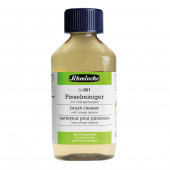
-
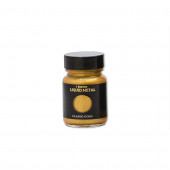
Roberson Liquid Metal 30ml
Starting at: £7.50
Roberson Liquid Metals have a rich deep colour, ideal for a wide range of applications including plaster, wood, paper & canvas. The Liquid Metal range does not tarnish and does not need to be varnished. All colours are intermixable and wash up with water. The Liquid Metal range does not tarnish and does not need to be varnished. All colours are intermixable and wash up with water. Coverage is approximately 7 square metres per litre. Two coats are required for most applications but if applied to walls or ceilings with a roller or a brush then three or four coats are recommended. Because of the highly reflective nature of the metallic paint when applying with a roller to a large area apply the paint evenly in long vertical strokes, finishing off the surface by rolling or brushing in one direction, i.e ceiling to floor. This will help to minimise overlapping and create a smooth and even finish. We recommend the use of a professional quality foam roller in order to achieve the best possible finish. When applying with a roller to a large area, apply the paint evenly in long vertical strokes. Finish off the surface by rolling one direction, i.e. ceiling to floor. This will help minimise overlapping and create a smooth, even finish. These paints can also be sprayed and this will produce the best and most consistent finish. To spray Liquid Metal Acrylics, you will need to use HVLP spray equipment with a 1.6mm or 1.8mm nozzle. To ensure proper flow, paint can be thinned with 25-30% water. Learn More -
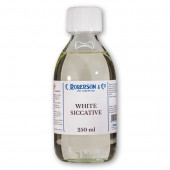
Roberson White Siccative
Starting at: £8.40
A strontium-based siccative, milder than cobalt driers. Add sparingly to oil colours to accelerate drying, particularly recommended for pale colours. Learn More -
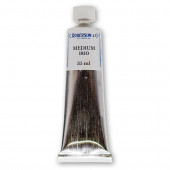
Roberson 1810 Medium
Starting at: £34.20
This is a traditional, high-oil "fat" painting medium, made using the highest quality materials. It will retain colour strength, is resistant to bleeding, has good flow release, is ideal for blending, and can be mixed with oil colours in any ratio. When dry, it creates an enamel-like surface.
Contains: Stand oil, Cold-pressed Linseed oil, Canada Balsam, Rectified Spirit of Turpentine, Beeswax, Driers.
Clean tools in white spirit. Do not use as a varnish, always mix with oil colour.
Learn More -
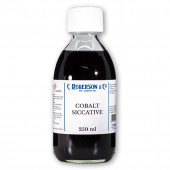
Roberson Cobalt Siccative
Starting at: £7.70
A cobalt drier in white spirit, to be added sparingly to oil colours to accelerate drying. Learn More -
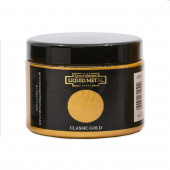
Roberson Liquid Metal 500ml
Starting at: £34.20
Roberson Liquid Metals have a rich deep colour, ideal for a wide range of applications including plaster, wood, paper & canvas. The Liquid Metal range does not tarnish and does not need to be varnished. All colours are intermixable and wash up with water. The Liquid Metal range does not tarnish and does not need to be varnished. All colours are intermixable and wash up with water. Coverage is approximately 7 square metres per litre. Two coats are required for most applications but if applied to walls or ceilings with a roller or a brush then three or four coats are recommended. Because of the highly reflective nature of the metallic paint when applying with a roller to a large area apply the paint evenly in long vertical strokes, finishing off the surface by rolling or brushing in one direction, i.e ceiling to floor. This will help to minimise overlapping and create a smooth and even finish. We recommend the use of a professional quality foam roller in order to achieve the best possible finish. When applying with a roller to a large area, apply the paint evenly in long vertical strokes. Finish off the surface by rolling one direction, i.e. ceiling to floor. This will help minimise overlapping and create a smooth, even finish. These paints can also be sprayed and this will produce the best and most consistent finish. To spray Liquid Metal Acrylics, you will need to use HVLP spray equipment with a 1.6mm or 1.8mm nozzle. To ensure proper flow, paint can be thinned with 25-30% water. This range of paints is suitable for exterior use but must be applied on a dry day as acrylics take longer to dry out completely than oil-based paints. Once dry the paints cure and are hardwearing. Learn More -
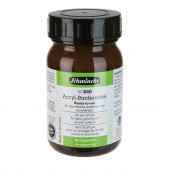
-
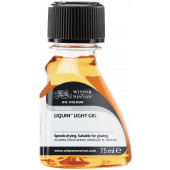
Winsor & Newton Liquin Light Gel
Starting at: £9.20
From the Winsor & Newton website: This quick drying gloss medium offers a slight gel that brushes out smoothly and is ideal for artists looking for a non-drip effect when mixed with colour. Speeds drying (touch dry in 1-6 days depending on colour and film thickness). Ideal for glazing. Resists yellowing. Not suitable as a varnish or final coat. Learn More -
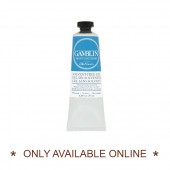
Gamblin Solvent-Free Gel
Starting at: £6.80
Gamblin Solvent-Free Gel is manufactured by the American company Gamblin. They write:
"Gamblin Solvent-Free Gel is the only solvent-free painting medium that supports a broad range of painting techniques with minimal compromise. Solvent-Free Gel gives colours more flow and transparency, yet holds the shape of your brushmark. Solvent-Free Gel has a moderately fast drying rate and increases gloss. Made from safflower oil and alkyd resin, Gamblin Solvent-Free Gel is non-toxic and contains no Gamsol or petroleum distillates. In comparison to other solvent-free mediums, Gamblin Solvent-Free Gel supports the broadest range of painting techniques with the least compromise across color, dry time, texture and mark-making. To ensure proper drying of paint layers, Solvent-Free Gel should be used in moderation with oil colors. No more than 25% by volume. To avoid wrinkling, apply mixtures of Solvent-Free Gel and oil colors thinly. To paint solvent-free, we recommend Gamblin Safflower Oil for cleaning brushes while you are working. After your painting session, brushes can be further cleaned using Gamsol and/or soap and water."
Learn More -
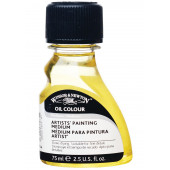
Winsor & Newton Art Painting Medium
Starting at: £9.20
From the Winsor & Newton website: A slow drying, gloss medium which is ideal for fine detail work, glazing and smoothly blended areas with no brush marks. Reduces consistency and improves flow. Suitable for oiling out and enriching dull patches. Resistant to yellowing.
Learn More -
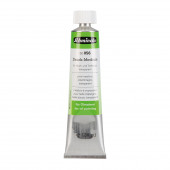
-
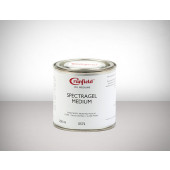
Cranfield (Spectrum) Spectragel Medium
Starting at: £16.50
From the Cranfield website:
This is a thixotropic alkyd medium designed to mix with oil colours, retaining the body of the paint.
Spectragel is a gloss medium and is quick drying. It is a clear medium based on a synthetic resin that improves the weather resistance of oil colours; ideal for glazing and extending colours while retaining gloss and structure of paint.
Matt Spectragel is a quick drying, clear, weather-resistant medium based on synthetic resin. Ideal for extending colours, Matt Spectragel Medium will retain structure and dry to a matt finish.
Learn More





